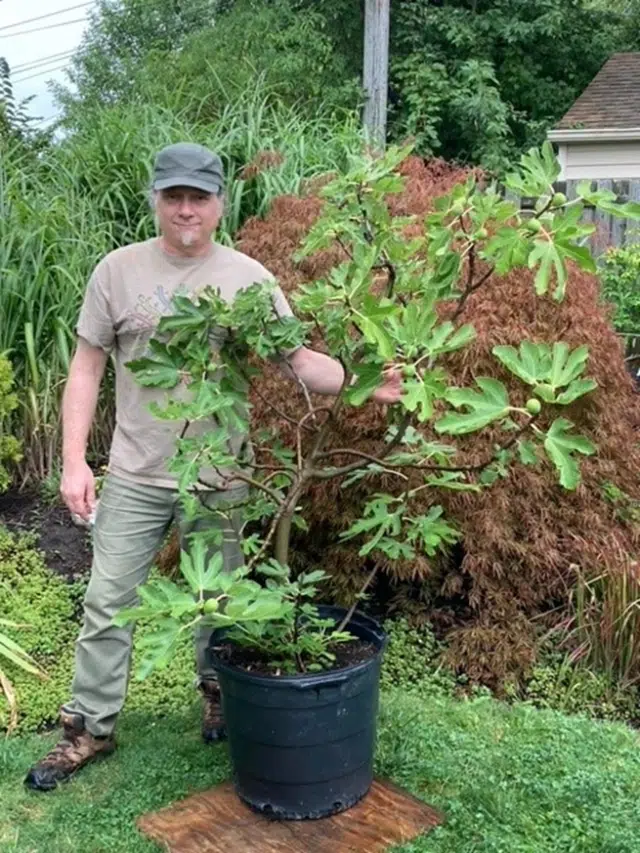
Figs have been cultivated for thousands of years and are one of the earliest plants to have been cultivated. They are originally from warm climates in western Asia and the eastern Mediterranean area. Figs can be eaten fresh, dried, or processed into many different desserts. I grow two varieties of fig, the Chicago Hardy and another, unknown variety which I was given by a family member.
Last Fall I planted my Chicago Hardy fig trees in the ground in a protected area and covered them with dead leaves and a tarp for protection over the winter and this summer they have grown well but only produced a single fruit. I expect they will get taller and make more figs next year. They are planted next to my patio and I think they looks good even without the fruit. For the last 5 years I had these figs in two containers, and they produced several figs each year and were over-wintered with my other figs.

More than 10 years ago I received the other, unnamed variety. There were six plants, 3-4 feet tall with a few short branches. They were not in great shape and took several years to recover.
Their year starts in late April when I wake them up from their winter sleep. They often have some tiny figs on the branches at this time. This is known as a Breba crop. In theory these figs will ripen early and then produce a second, larger crop which will begin ripening late in August but in my experience, they are delicate and usually lost to cool night temperatures. If there are any very cold snaps, I will protect the trees by covering them or moving them into my garage.
I grow them in containers, so they require frequent watering through the summer. The main crop are formed by July and begin ripening in late August. The fruit sits dormant on the branches until over two days one of the figs expands in size by three or four times and is ripe two or three days after that. The skin is green near the top and red on the bottom. The inside is white and red. The fruit is sweet.



My five largest fig trees are the ones that produce fruit. They are about 5 feet tall with a trunk diameter of about 2 inches and grow in 15 gallon containers. These have set 20-25 figs each this year. All the trees that have produced fruit for me have been six or more years old. There are continually new plants sprouting from the roots or base of the tree. I remove the new plants every year or two and pot them up. I have several mid-sized plants that I am guessing will begin fruiting over the next few years.
By the second week of November or earlier I put them all to sleep for the winter. In my garden, I dig a circular, shallow trench 3-4 inches deep, long enough to put all the fig pots in. Within the trench I put 6 inches of rotting compost. Beginning with the largest trees, I lay the pots down in the trench with the wood facing the interior. I lay the rest down, gently flattening the branches and weaving them together so none sticks straight up. I then take dry dead leaves and fill all the cavities below and within the plants and pots and cover all that with 2 feet more of leaves. I cover the pile with a tarp and secure it with soil and bricks. I take garden soil and fill any gaps between the pots and cover the edges of the tarp. If the wood sits in water it will rot. The figs will stay there through the winter until I pull back the tarp in early April to let some air in and begin waking them for the spring.


Matt Edwards
Animal Care Specialist
Matt Edwards, Animal Care Specialist, has been providing for our tropical animals and arthropods since the biomes opened in 2003. As a youth Matt first expressed his fascination for animals tending to chickens, goats and dairy cattle as a farm hand. He then added professional experience by earning an Associate of Arts and Sciences from Lakeland CC. When not caring for chameleons and leaf-cutter ants, Matt enjoys relaxing with his pets Henry the Pomeranian and Petunia the Tortoise.












